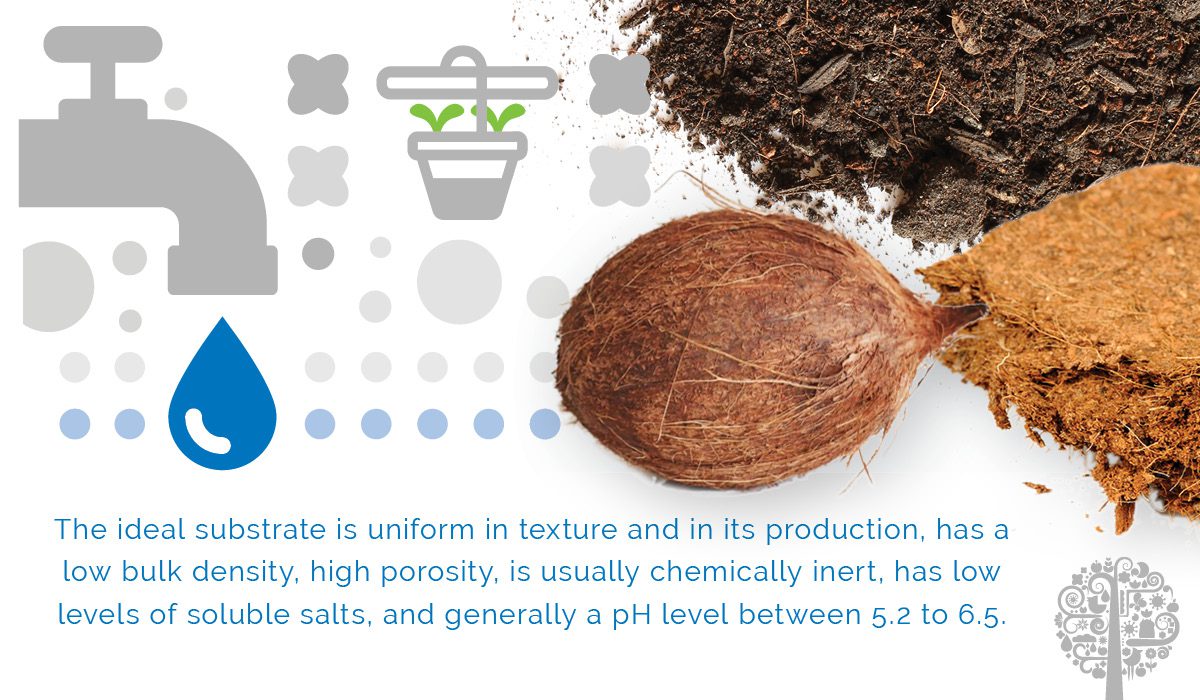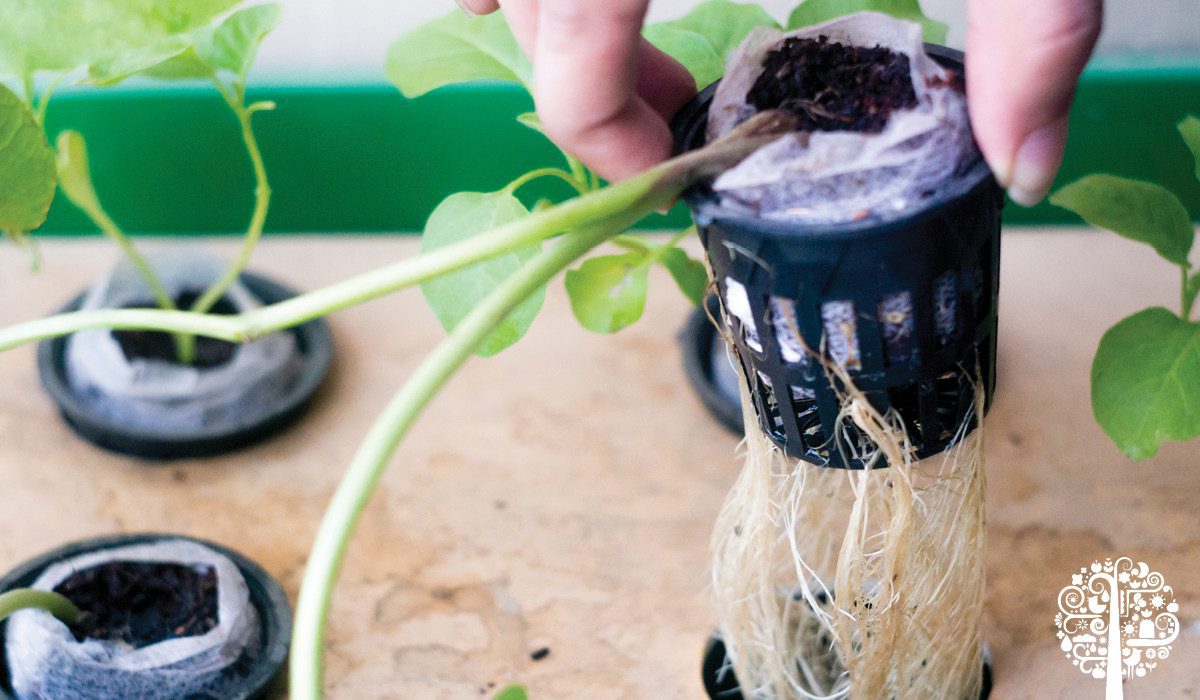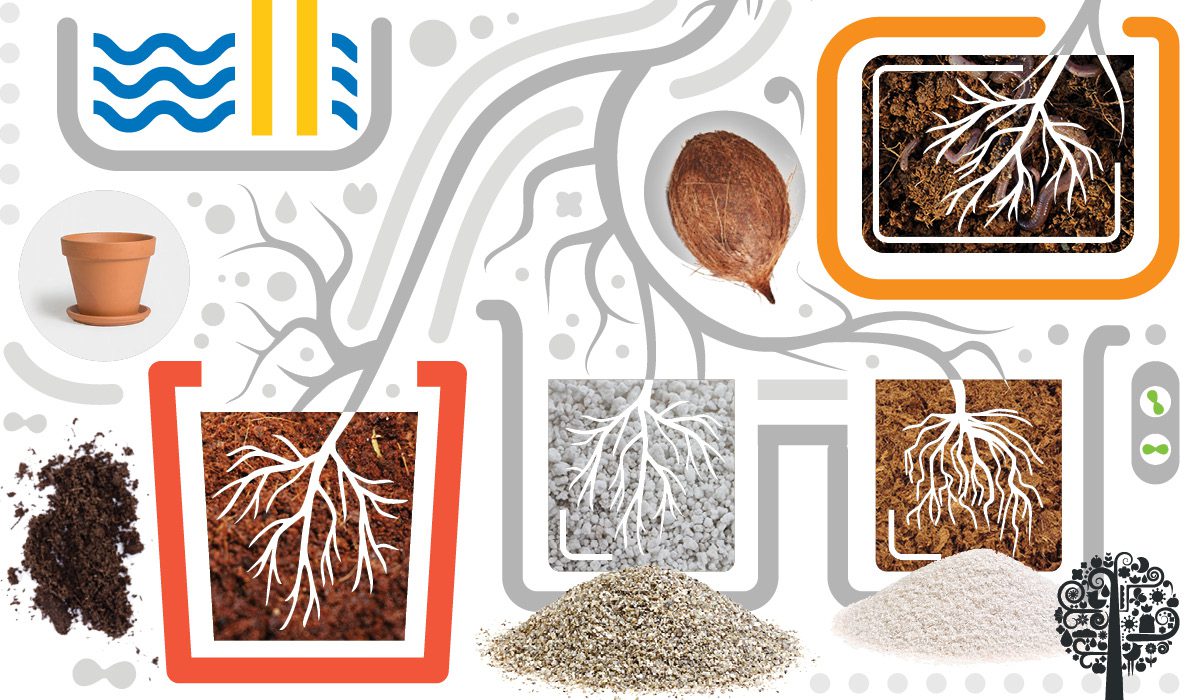In the field of hydroponics, much is made of your choice of system, your lamps, and nutrient solution. Thousands of articles have been written on the subjects, but a component of your indoor grow space that’s often overlooked is the growing media or substrate. Understanding the chemistry of substrates and how it affects plant growth is an important, yet often ignored, aspect in the development of the crop. In this article, we’ll explore the science, then look at how your choice of substrate influences plant growth.
The Science
We can broadly break down the science behind substrates into the chemical; Cation Exchange Capacity (CEC), pH, and Electrical Conductivity (EC), and the physical; air-filled porosity (AFP), Water Holding Capacity (WHC), and bulk density. Focusing first on the chemical, CEC measures a material’s ability to absorb and hold exchangeable cations, otherwise known as positively-charged nutrient ions (such as Ca, Mg, K, and NH4). The higher the measurement – typically expressed as centimoles per kg of material (cmol kg-1) – the greater the number of nutrients a substrate can retain and make available for plant roots, and the more resistant it will be to leaching during the watering process. In other words, it measures the buffering ability of your growing medium. A higher CEC is generally desirable because it means the medium not only absorbs but also releases cations from your nutrient solution, helping to stabilize pH and nutrient concentrations.
The Chemical
pH is a scale from 0 to 14 that shows us the acidity/basicity of a liquid (it can go below 0 and above 14 – but that’s another story). The lower the number, the more free hydrogen ions (H+) and the higher the acidity. The higher the number, the more free hydroxide ions (OH−), which signals greater alkalinity levels. The neutral 7 (although this can change depending on the temperature of the solution) marks the point where there are equal concentrations of H+ and OH-. A pH of 5.2 to 6.5 is the range we commonly call “the grow zone”. This is an essential aspect of substrate chemistry because pH affects the availability of nutrients to a plant. Get the levels wrong, and you’ll either starve or overdose the crop. Too low a pH increases micronutrient availability to a level that can induce a phytotoxic response, cause ammonium toxicity, phosphorous leaching, and calcium and magnesium deficiencies. But too high a pH and your plants can suffer from iron and boron deficiency. Crucially, you should do your research, as the pH requirement is different for different species. Some need a low pH (such as aubergine or blueberries), while others thrive in a high pH environment (for example, grapes or spinach).

Electrical conductivity (EC) is how one measures the total level of dissolved salts, or free ions, in the substrate. This is usually described in units of deciSiemens per meter (dS/m). Too much salt can negatively impact the osmotic potential (ψs) of your growing medium, resulting in water loss and stress in your plant roots.
The Physical
The texture and structure of a chosen substrate have a crucial effect on its air porosity and water retention. All substrates are effectively a network of pores, occupied either by gas or water and separated by mineral particles. The WHC of the media is the volume percentage of water that can be retained by a saturated growing media once drained. The AFP is measured by how much of this pore space is taken by air, similarly after drainage. Then there’s bulk density, the mass per unit volume of a substrate, generally shown as grams per cubic centimeters (g/cm3), i.e. the ratio of a bulk solid’s mass (m) to its volume (V), otherwise expressed as ρb=mV.

Generally, the wetter and more compact the medium, the higher the bulk density and the lower the number of pore spaces. This is important because the greater the volume of pore spaces, the better the air to water ratio. Bulk density is more of an issue when discussing soil-based growth. Most of the substrates used in hydroponics have a relatively low bulk density. The air to water ratio describes the balance of available water and air around the root zone. It is essential to nutrient exchange capacity, pH buffering, beneficial microbes, and disease prevention.
Organic vs Inorganic
Substrates broadly fall into two categories, organic and inorganic. Do not confuse the word “organic” here with the term used to describe natural farming methods. In chemistry, “organic” means a compound that contains carbon (such as coir or peat moss), and inorganic means the compound does NOT have carbon (such as Rockwool or perlite). Rockwool is made from silicon dioxide (SiO2), a chemically inert substance. The strong covalent bonds between the silicon and oxygen mean that it doesn’t dissolve in water, conduct electricity, or bond with other substances – including the free H+ ions and H3O ions in your nutrient solution. This means it has a low buffering capacity, leading to a greater pH fluctuation range around the root zone – although we can rectify this with regular flushing and continuous monitoring. Rockwool, perlite, sand and most inorganic media have a CEC of around zero, so they have next to no effect on the availability of cations around the root zone. Vermiculite, a hydrous mineral heated to expansion, has an extremely low bulk density, average CEC, and high WHC at 100-150 meq/100g, so there’s a risk of oxygen starvation in the root zone. Other mediums include LECA clay balls, which have excellent drainage and aeration qualities and are chemically inert. They have a low WHC and CEC but a high AFP.
In the organic corner, coir is comprised of many different organic molecules, including carbohydrates, polysaccharides, and residual salts such as sodium (Na+), potassium (K+) and chloride (Cl-). These compounds bond with and absorb free H+ ions, causing fluctuating pH around the root zone. This, in turn, aids with the absorption of nutrients. It has a high CAC, double the porosity of Rockwool, and a WHC that, at 88%, is even greater than peat moss. On the flip side, coir retains oxygen, resulting in raised microbial activity, fine if the bacteria or fungi are friendly, but less so when they’re not. Coir’s high WHC means it is susceptible to overwatering.

Peat moss, another organic substrate, has some cation exchange capacity, and therefore, buffers well against nutrient changes in the root zone. It has a high WHC, is relatively acidic with a pH of 4.4, and is prone to becoming quite unstable. A wetting agent is recommended to make it more absorbent. As an organic product, it can also decay, clogging your irrigation system, and lead to the growth of fungal spores. The UK Government announced that amateur gardeners in England will be unable to buy peat compost from 2024, with a gradual phasing out planned for commercial growers soon. This is part of a welcome plan to protect vulnerable peatland, and it’s strongly recommended you avoid incorporating peat moss into your grow space, no matter where you live.
The Best Substrate?
The ideal substrate is uniform in texture and in its production, has a low bulk density, high porosity, is usually chemically inert, has low levels of soluble salts, and generally a pH level between 5.2 to 6.5. It should also be free of pests, pathogens, and anything toxic for your crop! But ultimately, what’s more important than the choice of substrate is that the grower does his or her research and chooses a substrate compatible with their hydroponic system. Wick systems require a higher WHC, meaning coir is the preferable medium choice. But watch out for overwatering and consider a specially-designed nutrient solution to compensate for its CEC. Meanwhile, deep water culture systems are more suitable for the lower WHC of clay pebbles, and fans of total nutrient control prefer the extreme low CEC and high AFP of perlite. You can even explore the possibility of mixing and matching; after all, science is exploring!